Symmetrical Garden Ideas: Create Balance and Beauty in Your Outdoor Space
Creating a symmetrical garden can bring a sense of balance and harmony to your outdoor space. Whether you have a large backyard or a small garden, using symmetry in your design can enhance the appeal and make everything look more organized.
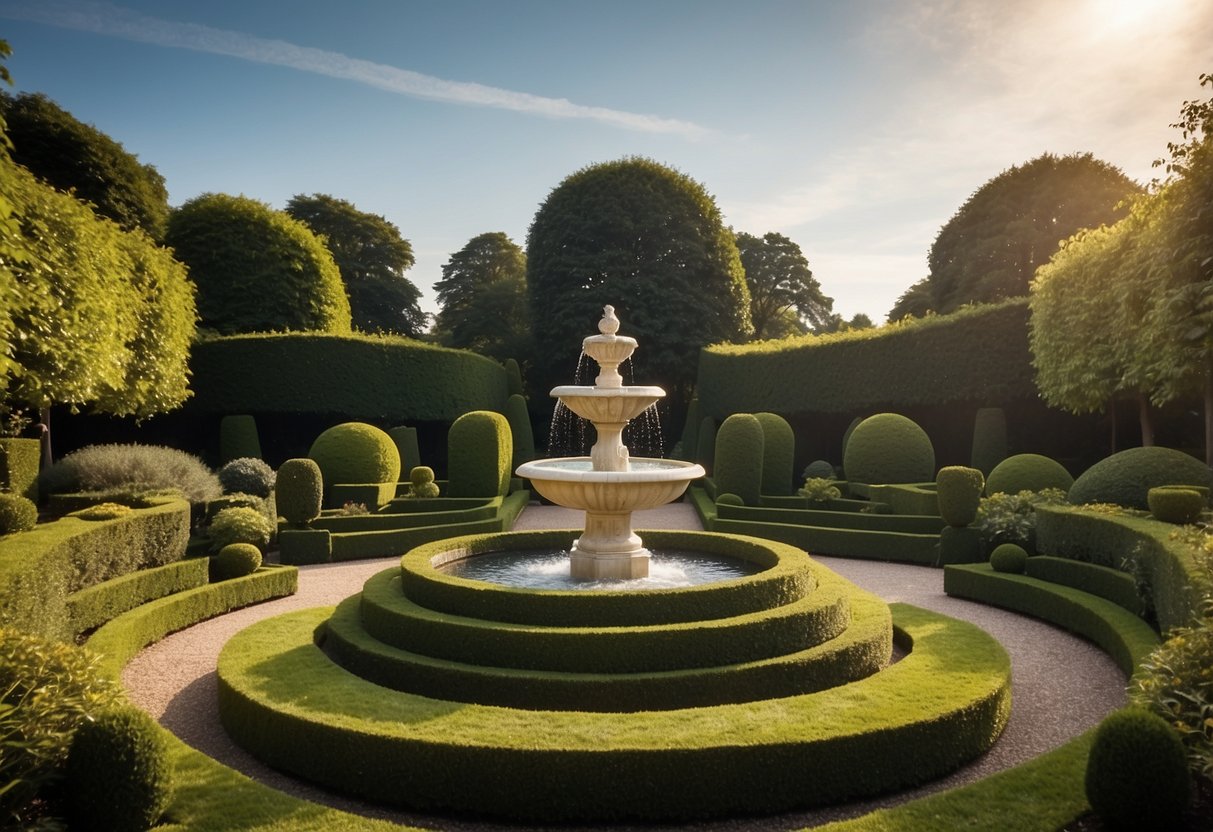
Are you looking to transform your garden into a well-balanced, visually pleasing haven? Symmetrical garden ideas can help you achieve a cohesive and beautiful landscape that feels just right.
1) Symmetrical Boxwood Hedges

Boxwood hedges can transform your garden into a neat and elegant space. Their evergreen nature makes them perfect for year-round appeal.
To achieve symmetry, regularly trim the hedges so they maintain an even and symmetrical shape. This can create a clean and organized look in your garden.
Consider planting boxwood in geometrical patterns. This adds a polished and classic touch to your landscape.
2) Mirrored Flower Beds

Mirrored flower beds create a balanced and pleasing look in your garden. You place identical plants or flowers on each side of a central line, making the garden feel ordered and harmonious.
Imagine a vibrant red rose on one side, mirrored by the same rose on the other side. This simple yet effective design can bring a sense of peace to your outdoor space.
Using symmetrical flower beds can be especially striking when viewed from a pathway or entrance. It gives visitors a clear and beautiful view, inviting them further into your garden. To explore more about creating symmetrical flower beds, you can visit this guide on designing with plant symmetry.
3) Classical Statues

Classical statues bring elegance and history to your garden. They can stand alone as focal points or be nestled among plants.
Use statues to define pathways or entry points. They guide the eye and create a sense of flow.
Opt for weathered pieces for a timeless look. Statues with patina add character, making your garden feel like it’s from another era.
4) Reflecting Pools

Reflecting pools add a touch of elegance to your symmetrical garden. These pools are typically shallow, enhancing the mirror-like effect of the water. This design choice creates a stunning visual that reflects the surrounding landscape and architecture.
You can customize the size and shape of your reflecting pool to fit your garden. Consider incorporating clean lines and simple shapes to maintain the symmetry.
For more inspiration, check out this guide on reflecting pools.
5) Geometric Grass Patterns

Geometric grass patterns can make your garden look neat and stylish. You can create these patterns using different shapes like circles, squares, or triangles. Use a lawnmower to trim your grass into these shapes.
Consider using pavers or gravel to outline your geometric designs. This adds a clean border and keeps the shapes looking sharp.
For a more dynamic look, combine different geometric patterns. Alternate circles and squares, or mix small triangles with large circles for a varied and interesting lawn design.
6) Perfectly Aligned Pathways
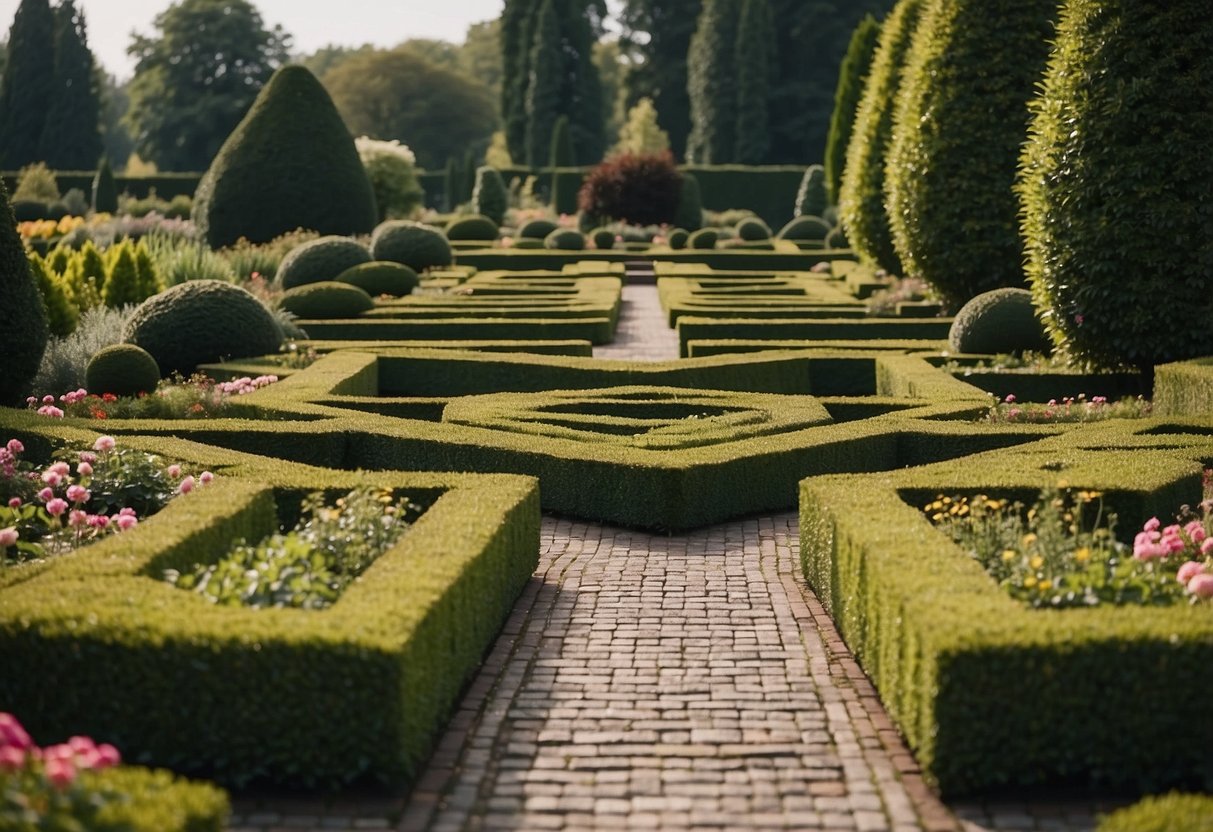
Symmetrical gardens shine with perfectly aligned pathways. Straight lines and balanced design can turn any garden into a picturesque retreat.
Consider a simple grass pathway lined with plants, like one at Domes Miramare Corfu. This creates a clean, organized look without needing stones or mulch.
Wooden slats and white gravel paths also offer a sleek and modern vibe to your garden.
7) Symmetrical Topiary Trees

Symmetrical topiary trees can add a formal touch to your garden. Cube-shaped topiaries are easy to create and work well for dividing different planting areas. You can also try globe, spiral, or pyramid shapes to make a statement around seating areas or entries.
Using symmetry, place identical topiaries on either side of a pathway or doorway to enhance the balanced look of your garden. Pairing them with matching plants or garden accessories can further emphasize the symmetry.
8) Matching Garden Arbors

Matching garden arbors give your space a neat, harmonious look. You can use two identical arbors to frame an entrance or a pathway.
By planting the same kind of climbing vines on each arbor, you create a balanced, green entryway.
For a charming effect, consider adding hanging planters filled with colorful flowers to both arbors. This will enhance the symmetry and beauty of your garden.
9) Symmetrically Planted Borders
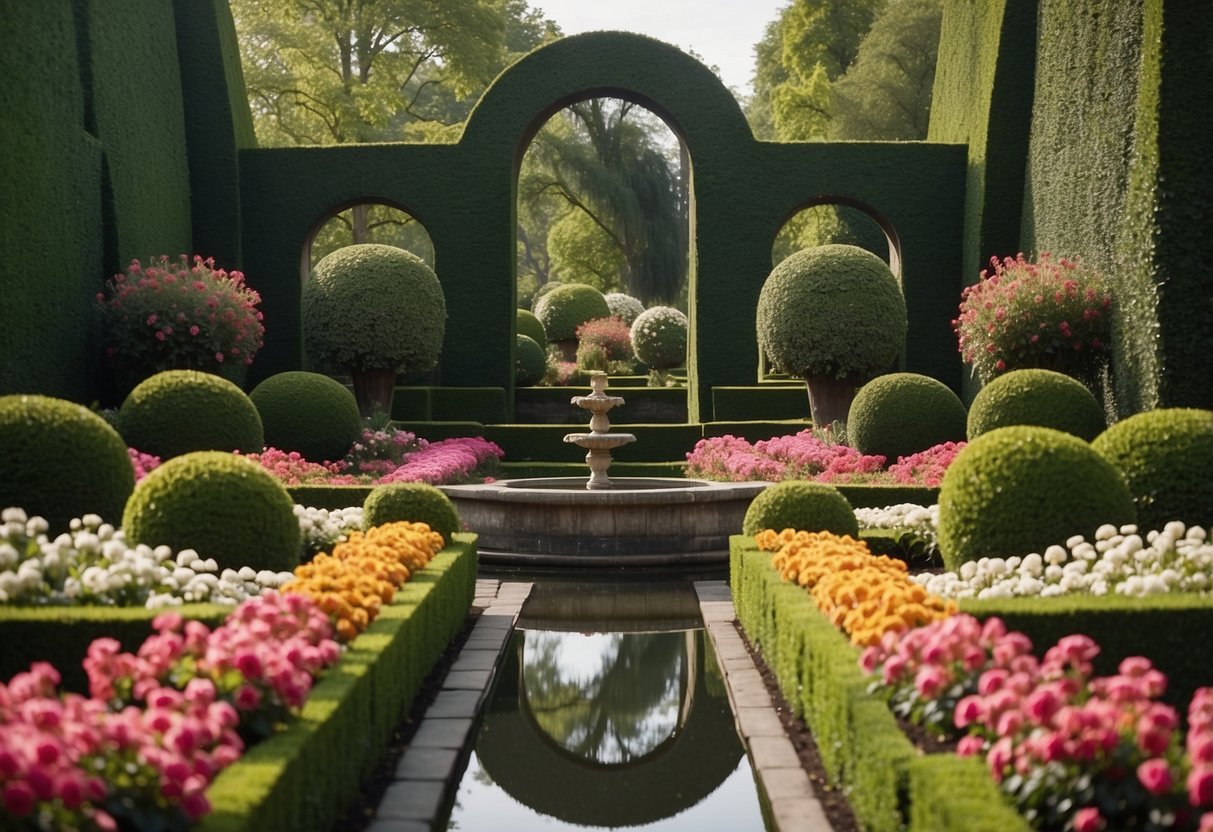
Symmetrically planted borders bring a sense of order to your garden. You can achieve this by placing identical plants or decor on both sides of a central path or focal point. This technique can make even a small garden look well-organized.
Choose plants with similar heights, colors, or shapes to enhance the balanced look. For example, pairing dark green shrubs with colorful flowers on each side can create a striking effect. Symmetrical borders don’t have to be rigid; you can mix and match plant types while keeping the overall layout balanced.
10) Twin Water Fountains

Twin water fountains can add a balanced and elegant look to your garden. They work well when placed on either side of an entrance or along a garden path.
Choose styles that match your garden’s theme, like Victorian or modern designs. Matching stone or metal fountains create a cohesive feel.
Adding symmetrical plantings around your fountains will enhance the overall design. You can see an example of this style with weathered metal statues and terracotta pots.
Principles of Symmetry in Garden Design
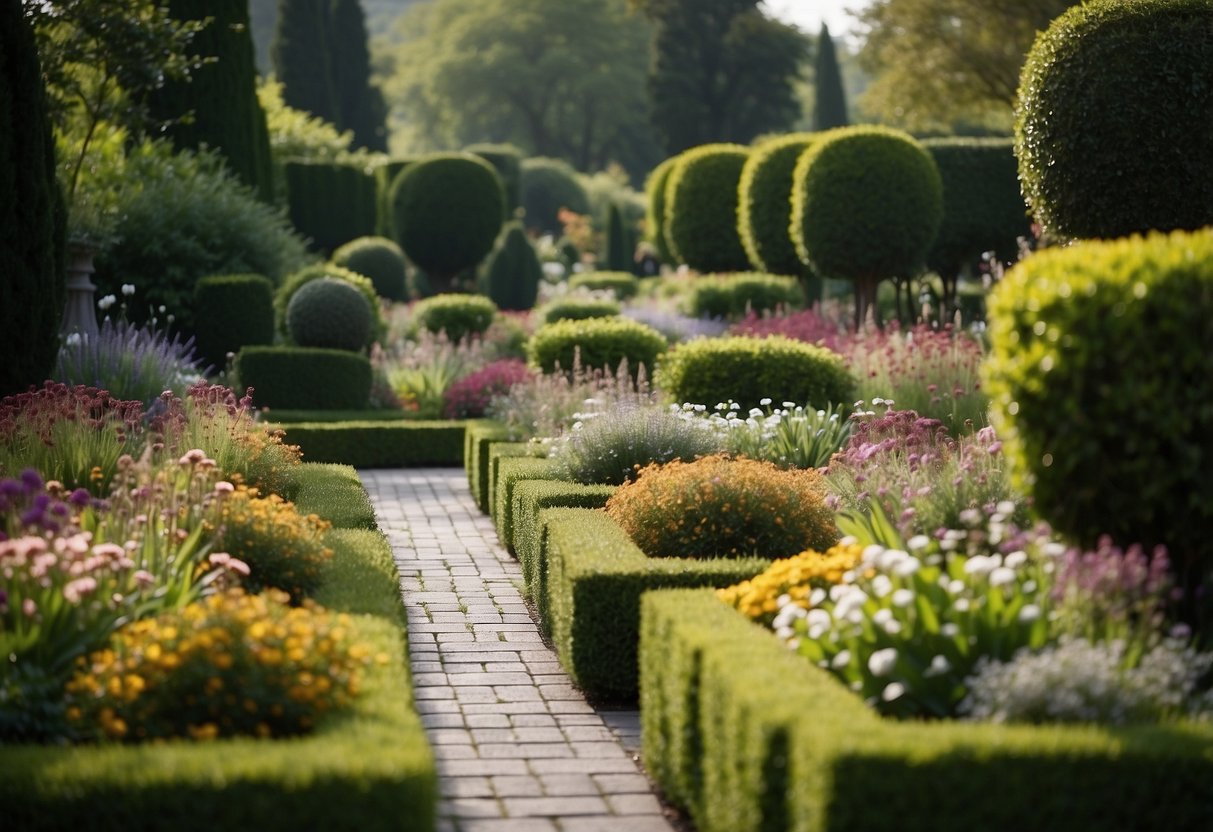
Symmetrical garden design uses balance and structure to create harmony. This involves understanding how to place plants and features effectively and recognizing the different forms of symmetry that can be applied.
Understanding Symmetry
Symmetry in garden design means arranging elements so they mirror each other on either side of a central line. Imagine splitting your garden down the middle; elements on one side should reflect those on the other. This creates a pleasing and organized look.
You can achieve this with plants, paths, and even garden furniture. Simple shapes and repeated patterns help guide the eye smoothly. Plants with similar heights and colors can maintain balance. Using identical planters or statues on each side is a classic example.
Types of Symmetry
There are various types of symmetry you can use in your garden. Formal symmetry is the most common and involves a strict, mirrored layout. This works well with classical gardens and straight pathways.
Asymmetrical balance, while not a mirror image, still creates harmony. For example, a large tree on one side can be balanced by a group of smaller shrubs on the other. Using different elements that have the same visual weight maintains a balanced look.
Rectangular gardens often benefit from bilateral symmetry, while circular gardens might use radial symmetry where elements radiate out from a central point. These principles help you design a garden that feels both structured and welcoming.
Design Elements for Symmetrical Gardens
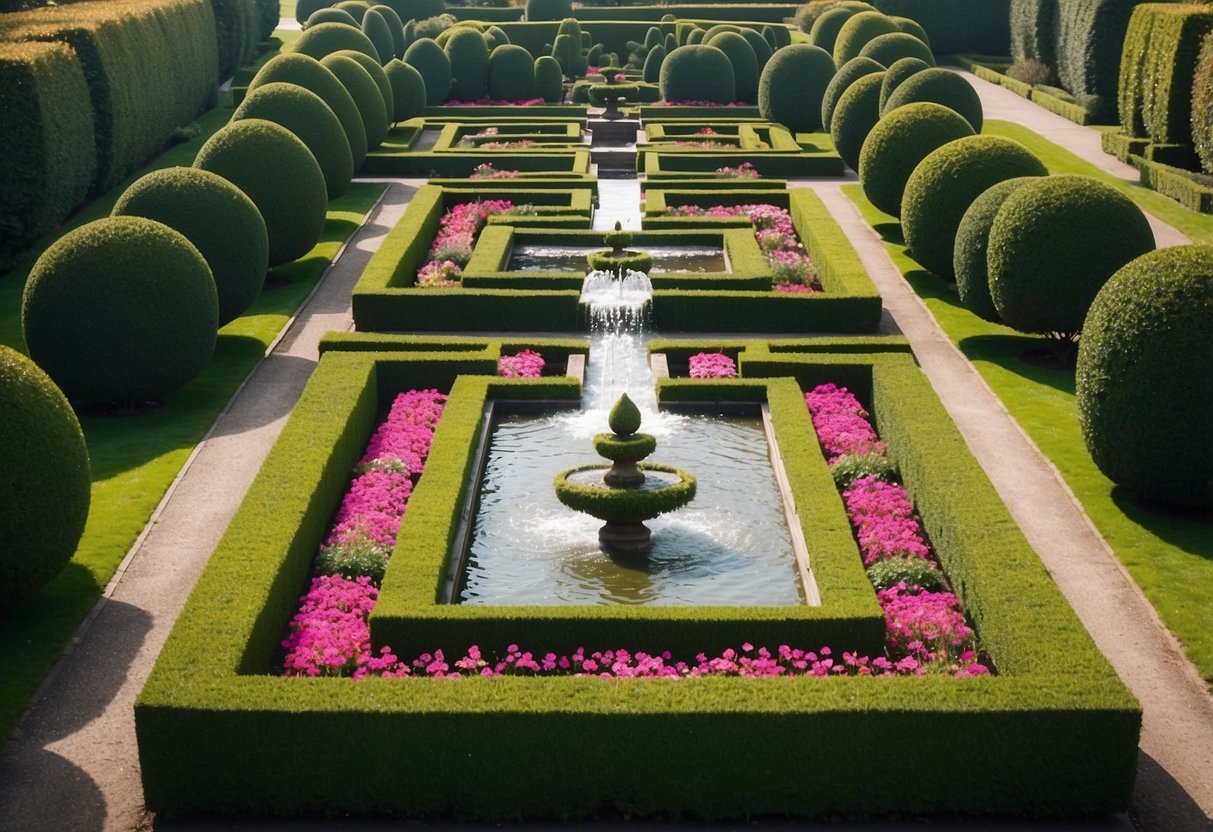
Creating a symmetrical garden involves careful planning and designing elements that mirror each other. Key components to focus on include pathways and walkways that provide structure and focal points that draw the eye.
Pathways and Walkways
Pathways in symmetrical gardens should be meticulously laid out to create balance. Straight lines or gentle curves work best, leading to a central axis or a main feature. Gravel, brick, or stone can be used to give a clean and polished look.
You might want pathways that intersect at right angles. These crossings can be accented with larger stones or special patterns. Borders along the paths can be edged with low hedges or flowering plants, enhancing the symmetrical design.
Consider adding circular or geometric shapes for more visual interest. For example, creating a circular path around a central fountain can add to the garden’s symmetry. Pathways should guide visitors smoothly through the garden, connecting various symmetrical elements seamlessly.
Focal Points
Focal points are essential in symmetrical gardens to draw attention and provide a sense of order. Classic choices include statues, fountains, or a pair of matching plants. Position these elements at the center or ends of pathways to emphasize balance.
Using identical garden benches, bird baths, or topiary sculptures on either side of a path can create harmony. Consider a pair of identical pots with colorful flowers placed symmetrically at the entrance.
Water features, like a central pond or cascading fountain, can serve as magnificent focal points. To maintain symmetry, ensure that surrounding plants and decorations mirror each other, creating a unified and appealing design.
Plant Selection and Arrangement

In a symmetrical garden, choosing the right plants and arranging them properly is key. Aim for plants with similar heights, textures, and colors to create a balanced and pleasing layout.
Choosing Symmetrical Plants
When selecting plants, consider their size and growth habits. For example, if you choose a tall, bushy plant for one side of your garden, pick another plant with a similar height and shape for the other side. This keeps the symmetry.
Color and texture are also important. A dark green shrub, like a boxwood, can balance well with another dark green plant. Avoid pairing it with a bright, light green plant as this can disrupt the balance.
Using plant pairs is also effective. Planting two of the same flower or shrub on either side of a path or centerpiece can create harmony. Think of roses, lavender, or low shrubs as good options.
Arranging Plants for Balance
When arranging plants, place the largest ones in the center or at the back and smaller ones towards the edges. This creates depth and balances the visual weight.
Use geometric shapes. For example, you can create a rectangular garden bed with matching plants on opposite sides. This makes the garden feel organized and neat.
Paths can help with symmetry. If you have a walkway, line it with identical plants on both sides. This not only looks good but also guides the eye naturally through the garden.
Symmetrical plant placement can involve mixing different plant types. For instance, balancing a large tree on one side with several bushes of similar height and width on the other can achieve symmetry. The key is to ensure each side looks and feels even.







